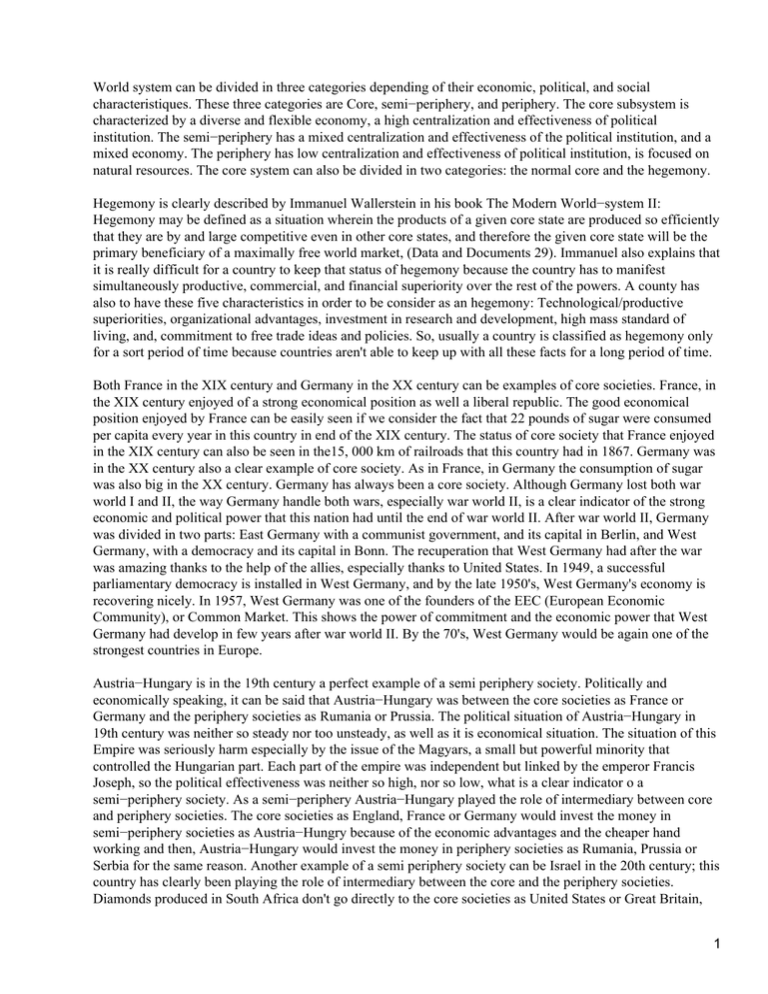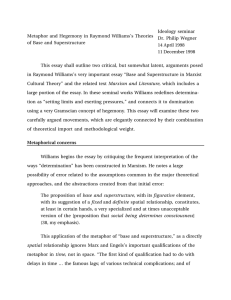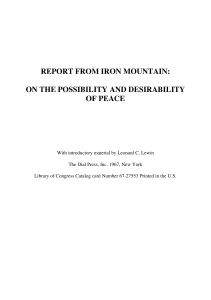Sistemas mundiales
Anuncio

World system can be divided in three categories depending of their economic, political, and social characteristiques. These three categories are Core, semi−periphery, and periphery. The core subsystem is characterized by a diverse and flexible economy, a high centralization and effectiveness of political institution. The semi−periphery has a mixed centralization and effectiveness of the political institution, and a mixed economy. The periphery has low centralization and effectiveness of political institution, is focused on natural resources. The core system can also be divided in two categories: the normal core and the hegemony. Hegemony is clearly described by Immanuel Wallerstein in his book The Modern World−system II: Hegemony may be defined as a situation wherein the products of a given core state are produced so efficiently that they are by and large competitive even in other core states, and therefore the given core state will be the primary beneficiary of a maximally free world market, (Data and Documents 29). Immanuel also explains that it is really difficult for a country to keep that status of hegemony because the country has to manifest simultaneously productive, commercial, and financial superiority over the rest of the powers. A county has also to have these five characteristics in order to be consider as an hegemony: Technological/productive superiorities, organizational advantages, investment in research and development, high mass standard of living, and, commitment to free trade ideas and policies. So, usually a country is classified as hegemony only for a sort period of time because countries aren't able to keep up with all these facts for a long period of time. Both France in the XIX century and Germany in the XX century can be examples of core societies. France, in the XIX century enjoyed of a strong economical position as well a liberal republic. The good economical position enjoyed by France can be easily seen if we consider the fact that 22 pounds of sugar were consumed per capita every year in this country in end of the XIX century. The status of core society that France enjoyed in the XIX century can also be seen in the15, 000 km of railroads that this country had in 1867. Germany was in the XX century also a clear example of core society. As in France, in Germany the consumption of sugar was also big in the XX century. Germany has always been a core society. Although Germany lost both war world I and II, the way Germany handle both wars, especially war world II, is a clear indicator of the strong economic and political power that this nation had until the end of war world II. After war world II, Germany was divided in two parts: East Germany with a communist government, and its capital in Berlin, and West Germany, with a democracy and its capital in Bonn. The recuperation that West Germany had after the war was amazing thanks to the help of the allies, especially thanks to United States. In 1949, a successful parliamentary democracy is installed in West Germany, and by the late 1950's, West Germany's economy is recovering nicely. In 1957, West Germany was one of the founders of the EEC (European Economic Community), or Common Market. This shows the power of commitment and the economic power that West Germany had develop in few years after war world II. By the 70's, West Germany would be again one of the strongest countries in Europe. Austria−Hungary is in the 19th century a perfect example of a semi periphery society. Politically and economically speaking, it can be said that Austria−Hungary was between the core societies as France or Germany and the periphery societies as Rumania or Prussia. The political situation of Austria−Hungary in 19th century was neither so steady nor too unsteady, as well as it is economical situation. The situation of this Empire was seriously harm especially by the issue of the Magyars, a small but powerful minority that controlled the Hungarian part. Each part of the empire was independent but linked by the emperor Francis Joseph, so the political effectiveness was neither so high, nor so low, what is a clear indicator o a semi−periphery society. As a semi−periphery Austria−Hungary played the role of intermediary between core and periphery societies. The core societies as England, France or Germany would invest the money in semi−periphery societies as Austria−Hungry because of the economic advantages and the cheaper hand working and then, Austria−Hungary would invest the money in periphery societies as Rumania, Prussia or Serbia for the same reason. Another example of a semi periphery society can be Israel in the 20th century; this country has clearly been playing the role of intermediary between the core and the periphery societies. Diamonds produced in South Africa don't go directly to the core societies as United States or Great Britain, 1 they go first to semi periphery societies as Israel and then to the core societies. This role of intermediary is also played to send military help to the periphery form the core societies when they want it to be sent based in their interests. So, when a core society as Unites States want to send military help to a periphery society as Guatemala, El Salvador or Honduras, the help would be send thought semi peripheries societies as Israel. So, semi periphery societies are beneficiated from their role of intermediary in the economical part but they have also to do some dirty job for the core societies. England in the 19th century was without a doubt the most developed society all around the world. It had joint all the characteristiques that a hegemonic society has to have to be considered as hegemony. It had of course technological and productive advantages, being the country in what the industrialization level was the highest: 132 pig−iron of kg were produced per person in 1860 where, in France only 26 were produced per person as well in the same year. The level of investment in researching was also high in this country, it can be easily seen since England was the inventor of almost all the new technologies. The standard of living was really high in this country as well, the appear of the new middle class in this country with all the new commodities that it would enjoy is a clear indicator of this high standard of living. London and some other cities in Britain had all kind of new commodities as running water and even sewers and refuses to make the cities cleaner and healthier. Britain had as well, the higher rate of percent of exportation of the world in the 19th century 33.2% against the 22.3% that Germany, the following country had. The government savings were also positive in this country in the 19th century. The political situation in Britain was probably the most liberal all around the world. It enjoyed considerable constitutional guarantees and a parliamentary regime having a relatively high suffrage. All of these factors indicate that Britain in the 19th century was the most developed country and, as a result, the hegemonic society of the 19th century. In the 20th century, Britain didn't seem to be in the same shape that it used to be in the 19th century. Britain didn't keep innovating as it used to do in the prior century. In the begging of the 20th century, a core society, United States seemed to be doing it pretty well, the inexpensive way of production that Ford used to make their cars was a clear example. But not until after the war world II, United States would be consider as the country that would occupied the position that Britain used to have as hegemony society. This fact can be seen in the goods that these two counties exported in the 20th century. In 1913, Britain export the 30% of all the goods that were exported among the five most developed countries being the leader in exportation of this countries, when United States only exported the 13% being the third country on the list. In 1950 United States was the leader in this category but only with two points of difference from Britain. It's in 1967 when United States really made a difference with Britain, United States exported in this year almost the double that the British did. So, it's few years after war world II when United States take the led in the world in all kind of fliends such as technology, investment in research, high standard of living, and international trade, and therefore it was considered as a hegemonic society. United States also had one of the most important issues that a country has to have to be consider as hegemony: a high effectiveness of the government and a democracy. So, in the 20th century United States became the hegemonic society in this century, and somehow it would be the nation that would rule the world up to the present. In the middle of the 20th century, something happen that put in risk the interests that the core and hegemony societies had in the periphery societies. The British had the control of almost all the Iranian petrol. But, in 1951, Mossadegh Mohammed became Prime Minister of Iran and decided to put end to the British domination by nationalizing the Petrol Company. Mossadegh knew that with this action not only he would finish with the British oppression in Iran, but also the relations between core and periphery societies would change: the action of Iran could be inmitated for many countries that were suffering the same kind of oppression, especially with the petrol issue. Of course, the British didn't like the intention of Iran about nationalizing the petrol company, and they also realized that this could be the first step of a great number of losses including the Suez Canal. So, at this point the British were ready for a military intervention. But what the British didn't realize was that Britain was not an Hegemonic society anymore and therefore, it was not able to solve a problem like this any more. Therefore, it was in this point when the new hegemonic society, in this case United States, had to take control of the situation. United States wasn't willing either that Iran got his point. 2 United States had also many counties like Kuwait, South Arabia, and Iraq in the same condition that the British did, So, it wasn't either in the United State's interest that Iran got his point in this issue, because it could be also like for the British, the first step in a series of rebellions in the countries that United States controlled. So, when it was obvious that Britain wasn't able to solve the problem by itself, the United States took control of the situation. United Estates negotiated with Iran to find a solution neither as rush to the British as the nationalization of the Petrol Company, nor as oppressive to Iran as the total control of the Iranian Petrol Company that the British had had. In this conflict and in the mode that it was solve, it can be easily seen the important role that the hegemonic society has in the world system, as well as the limitations that the core societies may have sometimes to solve some kind of problems. It is also seen how Britain has to give up his position of hegemony and United States clearly consolidated his status as the new hegemonic society in the 20th century. 6 3




